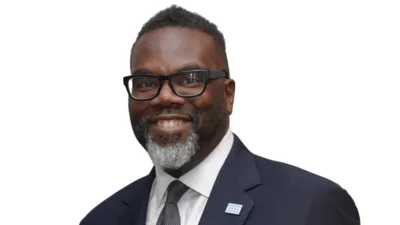Chicago Metropolitan Agency for Planning Environment and Natural Resources Committee met Feb. 7.
Here is the minutes provided by the committee:
Members Present: Keary Cragan – U.S. EPA, Jack Darin – Illinois Sierra Club, Martha Dooley – Village of Schaumburg, Sarah Edwards (for Deborah Stone) – Cook County Department of Environmental Control, Danielle Gallet – Metropolitan Planning Council, Tom Rickert – Kane County, Mike Sullivan – IDOT, Sean Wiedel – Chicago Department of Transportation,
Members Absent: Lynn Boerman – IDNR, Stacy Meyers – Openlands, Mike Warner – Lake County Stormwater Management Commission
Staff Present: Nora Beck, Sarah Buchhorn, Brian Daly, Kama Dobbs, Kate Evasic, Doug Ferguson, Kelwin Harris, Stephanie Levine, Jason Navota, Jared Patton, Sarah Walwema, Simone Weil
Others Present: Garland Armstrong, Heather Armstrong, Edith Makra
1.0 Call to Order
Sean Wiedel called the meeting to order at approximately 9:30 a.m.
2.0 Agenda Changes and Announcements
A public comment period is open for CMAP’s consideration of two requests for amendments to ON TO 2050’s list of fiscally constrained regionally significant projects (RSPs). The requests are both from the Chicago Department of Transportation (CDOT): 1) Roadway Improvements to Support the Update to the South Lakefront Framework Plan (more commonly known as the Jackson Park Transportation and Mobility Improvement Project), and 2) O’Hare Express System. The public comment period is open until February 25, 2019. CDOT will give an overview presentation on the O’Hare Express System at the CMAP Transportation Committee meeting on February 22, 2019.
3.0 Approval of Minutes
A motion to approve the minutes of the November 1, 2018 meeting was made by Tom Rickert, seconded by Martha Dooley. The motion carried with all in favor.
4.0 2019 ENR Committee Work Plan – Brian Daly and Kate Evasic, CMAP
Staff presented recent changes CMAP has adopted to its committee structure and procedures to help facilitate a robust implementation of the ON TO 2050 plan. Staff shared a memo that was presented to the CMAP Board reviewing the agency’s committee structure and a draft document summarizing terms of committee membership. The committee discussed the work plan for 2019, as well as offering input on potential meeting content and logistics.
Committee changes. Members asked if the combined land use and housing committee will have a new name. Staff responded that it will be called the Land Use and Housing Committee.
Coordinating Committee. Staff noted that the first meeting of the new coordinating committee will be February 13th.
ENR Committee Member Survey. The survey is still open and members should try to respond by February 15th.
ENR Committee Membership. Members asked whether there is a set number of members the committee should staff. Staff responded that it is not a fixed number – there are currently ten members, with four to five seats to fill, but that number is flexible. Staff said that members can submit names of potential candidates for the committee.
Committee attendance. Staff agreed that attendance by phone can be used by request in special circumstances, but that in- person attendance is preferred when possible. Staff also said that proxies can be sent, but that they should be people who can fully participate in the committee discussion.
Committee activities.
o Members would like the chance to weigh in on LTA projects earlier in the planning process when their input can be more valuable, and receive updates when the projects are completed. Members would like to understand how presented LTA projects could apply elsewhere in the region.
o Members asked how CMAP is promoting the investment made through the LTA program. Staff responded that they are thinking about ways to communicate LTA project implementation.
o Members also expressed interest in providing feedback on the overall project types sought in future LTA Calls for Projects, as well as the chance to look at the list of new projects and identify a few they would like to track.
o Members noted that climate-related projects would offer good opportunities for coordination across different committees’ expertise such as transportation.
o Members expressed interest in presentations on future RSPs.
o To diversify committee activities, field trips would be welcome.
Committee meeting schedule. Members agreed that less frequent, longer meetings would be desirable going forward. Staff noted that committees that meet less often still have meetings that are under two hours in length.
Communication. Members asked that member contact information be shared among themselves.
Staff follow-up. CMAP will revise the committee charge based on the feedback received at the meeting and will share the revised version. Staff will also share a proposal for a revised committee meeting schedule for 2019.
5.0 Call for Transportation Projects – Kama Dobbs and Doug Ferguson, CMAP
From January 15 to March 15, CMAP is holding a call for projects for the regional Surface Transportation Program (STP) Shared Fund, Congestion Mitigation and Air Quality Improvement Program (CMAQ), and locally programmed Transportation Alternatives Program (TAP-L). Using a presentation, Kama and Doug reviewed these federal programs, which fund surface transportation projects that improve transit, traffic, bicycle facilities, freight, safety and alternative fuel vehicles and equipment. Committee members asked a number of clarifying questions and had the following comments:
Electric vehicle charging stations. Stations are eligible under CMAQ. To evaluate applications, assumptions must be made about their usage rate.
Required obligations. The requirement to obligate 20% of the CMAQ program to particulate matter reduction is no longer applied because the region is now in attainment on particulates. Projects that reduce particulates are often still very competitive due to their overall benefits.
Follow-up with applicants. Because CMAP staff receives about 120 applications per year and funds about 50, staff cannot debrief every unsuccessful applicant. If anyone requests more information, staff does provide feedback on their application. Some applicants successfully reapply in subsequent years, some projects are never implemented, and some find alternative funding.
Components of direction emissions reduction project applications. For direct emissions reduction projects, there is no Phase 1 engineering requirement, but the applicant must provide a detailed cost estimate.
Geographic distribution. CMAP tracks the locations of projects and applications, but do not focus heavily on it.
Equity and capacity. Members asked whether there is a way to work through the LTA program to help lower capacity programs apply. Staff noted that there is a hardship exemption from certain parts of the application requirements, based on the same criteria for capacity that LTA uses in evaluating applications. Communities in Cohort Four can apply for funds that can be used to complete Phase 1 engineering to support future applications for the full project. The project is still evaluated based on its
STP Shared Fund.
Inclusive growth. Criteria is included to capture inclusive growth benefits.
It focuses on the users of a proposed facility, rather than on characteristics of the project sponsor who is applying.
Greenhouse gas reduction goals. In response to a question about using ON TO 2050’s greenhouse gas indicator target as evaluation criteria, staff noted that the scale of the transportation fund is too small to move the needle on the region’s overall performance on this indicator.
6.0 Robbins TOD and Industrial Area Plan – Kelwin Harris, CMAP
CMAP staff presented on current LTA work in the Village of Robbins. As a part of CMAP’s Local Technical Assistance (LTA) Program and RTA’s Community Planning Program, an analysis of the opportunities to maximize development potential in Robbins is being conducted to support the flooding mitigation and park development proposed by the Metropolitan Water Reclamation District of Greater Chicago (MWRD). Informed by Village leadership and residents, MWRD chose to look beyond standard engineering by involving numerous partners to maximize the opportunity and achieve economic and quality of life benefits for the community. As parts of Robbins are currently in a floodplain, Robbins Park will create new opportunities for development that were impossible before.
Cost of implementation. There is not a full estimate of the cost of the various components of the plan at this stage. Market studies see a $28 million leakage of economic activity from the study area. MWRD is committed to constructing the stormwater park for roughly $10 million, but other recreational amenities in the plan will be additional. MWRD is also committed to funding additional detention for nearby development. Members noted the potential connection to upcoming discussions of a state capital funding bill.
Park maintenance. There is a local park district serving the area, but the responsibility for ongoing maintenance of the park is currently unresolved.
Partnerships. SSMMA is a partner in the project, but does not have an active role. The project team keeps them informed about the planning process. The project has been developing for about five years, and has attracted considerable interest and attention from partners. CCDOTH has made related commitments. MWRD see the project as a model they would like to replicate – they would invest in stormwater infrastructure, spurring related planning and redevelopment.
7.0 Other Business
None.
8.0 Public Comment
Heather Armstrong commented on the need to keep the region’s environment clean, and suggested that Illinois should have a deposit on bottles and cans to encourage recycling, as in Iowa and Michigan.
Garland Armstrong commented on the need to make sure air quality and environmental quality benefits reach residents of the region who have disabilities.
9.0 Next Meeting
The next meeting will be March 7 at 9:30 am in the Lake County conference room.
10.0 Adjournment
The meeting adjourned at 11:10 a.m.
https://www.cmap.illinois.gov/documents/10180/937360/2019-03-07-ENR-3.0-Minutes-2019-02-07.pdf/bbe94194-e411-6202-ef02-57e00380c4ce






 Alerts Sign-up
Alerts Sign-up